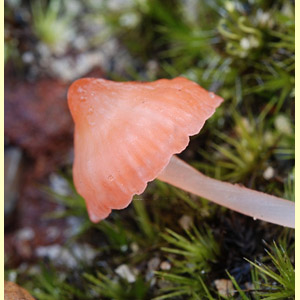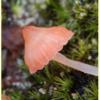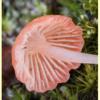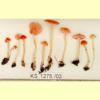
images/Mycena_section_Adonideae/FC_1372d_Sp._477_Mycena_sp_rosy_-_Robinson.jpg




Diagnostic characters
Small agaric, growing on the ground or litter, with a white spore print. Pileus pale or red or pink, not viscid. Lamellae adnexed, adnate, sinuate or adnate with a decurrent tooth. Stipe central. Partial veil remnants absent. Spores hyaline, non-amyloid, smooth; germ pore absent. Cheilocystidia present. Lamellar trama regular. Pileipellis a cutis. Clamp connections absent, rarely present.
Similar genera
The pinkish, pale red or red pileus on a long, thin, non-viscid, white or pale stipe is distinctive. Similar in general appearance to various other species of Mycena, but readily distinguished from red species in sections Galactopoda and Rubromarginatae, such as M. kuurkacea and M. kurramulla, by the non-amyloid spores, the absence of latex and the concolorous lamellar edge.
Citation
Mycena section Adonideae (Fr.) Quél., Mém. Soc. Émul. Montbéliard, sér. 2, 5 [Champ. Jura Vosges 1]: 103 (1872).
Australian species
Two species: Mycena aff. adonis and M. wubabulna. Mycena section Adonideae is keyed out separately because it differs significantly from other groups within Mycena by the non-amyloid spores.
Australian distribution
W.A., Qld and N.S.W. (and possibly also N.T., Vic. and Tas.).
Habitat
In native forest.
Substrate
On rich soil or on litter.
Trophic status
Saprotrophic.
References
Breitenbach, J. & Kränzlin, F. (eds) (1991), Fungi of Switzerland. Volume 3. Boletes and Agarics 1st part. Edition Mykologia, Lucerne. [Illustration, Description and Microcharacters of M. adonis and M. flavoalba, European species in section Adonideae]
Grgurinovic, C.A. (2003), The genus Mycena in south-eastern Australia. Fungal Diversity Press, Hong Kong and Australian Biological Resources Study, Canberra. [Description, B&W Illustration and Microcharacters for M. wubabulna]
